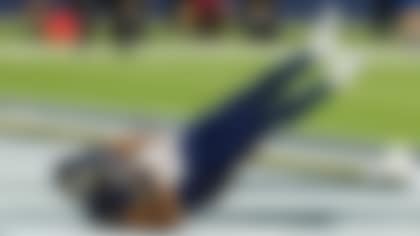Preseason football is not an accurate predictor of regular-season success, but you certainly can track trends that will appear on the field when the real action commences. In the 2013 preseason, I see more and more teams turning to no-huddle offense and up-tempo tactics to jump-start production.
While this isn't an entirely new development -- just prior to my arrival in the 1994 NFL Draft, the Buffalo Bills rode the K-Gun to four straight Super Bowl appearances -- the recent success of the no-huddle/spread offense on the collegiate level has more NFL offensive coordinators flirting with up-tempo schemes.
Here are four reasons why NFL offenses are picking up the pace:
1) A faster pace leads to more plays and scoring opportunities.
It seems like an elementary explanation for playing faster offensively, but it's really just that simple: Proponents of up-tempo football say the quickened approach leads to more offensive plays and possessions, which eventually results in more points. One thing I found interesting was that, at Pac-12 Media Day, Arizona head coach Rich Rodriguez told me that the emphasis is really on collecting first downs. He talked about tallying 30-plus first downs when the offense is really clicking.
Harrison: Picking the All-Pros
Elliot Harrison looks into his crystal ball to fill out an All-Pro roster for the season to come -- and some names might surprise. **More ...**
Of course, the college game is more conducive to playing at a breakneck pace, given the shorter play clock and wider hash marks. But NFL teams are starting to see the benefits, as well. The New England Patriots led the NFL last season with an average of 74.4 plays per game (nearly 10 plays more than the average team), and reached as many as 92 plays in a contest. Part of their success can be attributed to running the no-huddle on over 31 percent of their snaps. Although other teams like the Denver Broncos spent more time using the no-huddle attack, the Patriots typically played at a faster pace by routinely snapping the ball within 15 seconds of it being set by officials. Consequently, the Patriots routinely get off three or four plays in a minute when operating at warp speed.
Now, this might not seem like much of an advantage on the surface, with a number of teams placing an emphasis on the time of possession battle, but the fact that the Pats led the NFL in scoring by almost five points per game unquestionably has led other teams to study the no-huddle approach and adopt it into their game plans.
2) No-huddle offense limits defensive substitutions.
To play sound defensive football in today's NFL, defensive coordinators must be able to handle the myriad of personnel groupings, formations and shifts offensive coaches use to create an advantage at the point of attack. As the league has shifted to a more pass-oriented game, defensive coaches have begun countering this transition by sending in designated specialists to rush or cover as part of exotic nickel or dime packages. Additionally, defensive play callers have been rotating in seven and eight defensive linemen to keep a fresh set of pass rushers on the field at all times.
Offensive coordinators, however, have thwarted those tactics by extensively utilizing the no-huddle offense to keep opponents from substituting personnel. By eschewing the huddle, the offense forces the defense to stay alert and ready, while also restricting the defensive coordinator from sneaking in replacements and specialists to get after the passer. This is especially problematic when the offense rips off six or more plays in a rapid sequence. Defensive linemen exert a ton of energy battling through blockers and hunting quarterbacks, which makes the prospect of lining up over and over again without sufficient rest a daunting task. Additionally, the fatigue brought on by the up-tempo pace makes defenders vulnerable to running plays late in drives.
From a schematic standpoint, the formational flexibility of "11" (1 RB, 1 TE, 3 WR) and "12" (1 RB, 2 TE, 2 WR) personnel packages makes it easy for offensive coordinators to cleverly create mismatches in the run and passing games. For instance, the Patriots have extensively used double tight end sets in recent years with a conventional tight end and a "move" tight end aligning in a variety of spots to create matchup problems for the defense. When coupled with a no-huddle tempo, the formational flexibility puts the defense in a bind: The defensive coordinator must determine whether to stay in base defense to defend against the run or trot on the nickel package to match up better against the pass.
This preseason, I've seen more teams take advantage of the diversity of "11" and "12" groupings. Chip Kelly's Philadelphia Eagles, in particular, have seamlessly transitioned between the packages in their no-huddle offense. The screengrabs below display a sequence of plays from the Eagles' opening drive against the Carolina Panthers in Week 2 of the preseason. As you can see, the Eagles stay in their "12" personnel package, with rookie Zach Ertz aligning in various spots as the "move" tight end:
With more teams utilizing hybrid tight ends, the use of the no-huddle offense creates a decided advantage for teams willing to play fast.
3) Young quarterbacks can thrive against simplified fronts and coverages.
Proponents of no-huddle and up-tempo offenses point out that the rapid pace of play forces opposing defensive coordinators to simplify their game plans. Fear of miscommunication from the sideline to the field tends to make defensive play callers scale back on blitzing, while the inability to freely substitute defenders eliminates most of the exotic fronts and coverages utilized on passing situations. Additionally, the quickened tempo forces defenders to abandon the pre-snap disguises that can create indecision in the quarterback's mind at the line of scrimmage.
As a result, quarterbacks of up-tempo offenses play with more confidence and decisiveness from the pocket. This results in more completions and first downs -- and fewer costly miscues. Of course, some of the effectiveness is the byproduct of the quick-rhythm throws that are key components of no-huddle game plans, due to the need to string together positive plays and retain possession of the ball.
Examining the preseason success enjoyed by Buffalo Bills rookie EJ Manuel -- before his injury, of course -- I noticed that most of his throws were within 10 yards of the line of scrimmage. Manuel, the only quarterback taken in Round 1 of the 2013 NFL Draft, piled up completions on slants, quick outs and stick routes from a variety of three-by-one (trips) formations. Although it is easier to identify vulnerable areas of coverage with trips alignments, I believe the rapid pace of the offense kept defenders from honing in on Manuel's tendencies, allowing the rookie to get in a rhythm, gain confidence and make effective plays from the pocket.
Everyone wants to put their quarterback in the best possible position to succeed, so advantages gained from up-tempo pacing/no-huddle schemes will continue to influence teams across the league.
4) Blending tempo with read-option/packaged plays creates chaos on a D.
The influence of the college game definitely has played a part in more offensive coordinators using up-tempo tactics. NFL play callers are seeing the positive effects of fast-paced football when coupled with the spread offense, which has led to more experimentation with other college concepts like the read option and packaged plays.
Last season, the read option took the NFL by storm, as athletic quarterbacks tormented opponents with deft ball-handling and running skills. While defensive coordinators have descended upon college campuses in search of counter-tactics, offensive play callers have continued to build on the concept to create more chaos in 2013. Looking at the first few weeks of the preseason, I've seen more teams add the wide receiver screen package to the read option, giving quarterbacks an additional option on the perimeter. This is particularly problematic for defenses because it gives the quarterback three choices on each play: handoff, keep or throw. Factor in the use of a quickened pace, and a team could run the same play in succession with multiple players touching the ball.
Michael Vick officially landed the starting job for the Eagles after a pair of flawless preseason outings, and it's easy to imagine how he'll capitalize on all of these tactics. In the tape that I reviewed, though, Nick Foles just so happened to be in the game for a number of packaged plays that beg to be diagrammed in this column. So, no, I'm most definitely not trying to make any type of statement below in breaking down plays with Foles -- not Vick -- at QB. Conceptually, it's all the same.
Foles sticks the ball in the running back's belly and reads the reactions of the defensive end and nickel corner:
When the defensive end crashes on the running back, Foles pulls the ball and races around the end while reading the reaction of the nickel cornerback. When the defender steps up to meet him in the alley, Foles has Jason Avant open for a completion on the outside:
Here is another example of the Eagles executing the read option with a bubble screen. Foles puts the ball in the belly of the running back on an inside zone run and reads the reactions of the defensive end and play-side linebacker:
When the defensive end and linebacker both hesitate on the fake, Foles quickly pulls up and fires the ball out to Avant on the screen for an easy completion and positive gain:
Offensive coordinators are also utilizing run-pass combination plays -- the offensive line blocks the run play called by the quarterback, while receivers run designated routes on the perimeter -- to expand the effectiveness of the no-huddle offense. Now, the concept of adding a quick route on the backside of a run is not a new one. In fact, as a member of both the Green Bay Packers and Oakland Raiders in the mid-1990s, I watched Brett Favre and Rich Gannon repeatedly throw smoke or dart routes to the split end on the backside of isolation or power plays. But today's teams are increasingly utilizing the tactic with the advent of the fast-paced, no-huddle offense. Ripping off big plays at a rapid rate, teams can employ the same run-pass play multiple times in succession.
In the following screengrab, the Eagles are lined up in a trips formation, with the receivers assigned to execute a draw-stick concept. Foles is tasked with reading the reaction of the linebacker and making the decision to hand the ball off or throw to exploit a weakness of the defense:
When the linebacker drops back to defend the route, Foles hands the ball to the running back on the draw play:
While the play only gains two yards -- due to a fine open-field tackle by Thomas Davis -- it's a nice illustration of this concept.
Follow Bucky Brooks on Twitter @BuckyBrooks.












